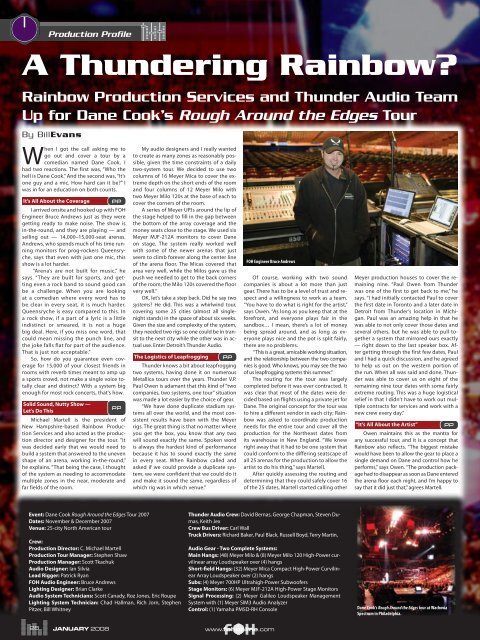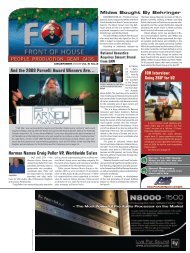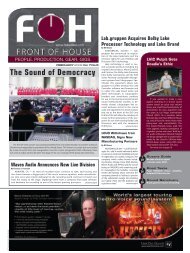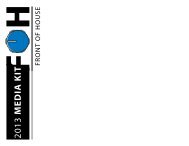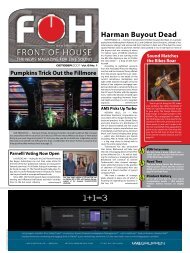X2's “Audio As Data” Approach Addresses Wireless ... - FOH Online
X2's “Audio As Data” Approach Addresses Wireless ... - FOH Online
X2's “Audio As Data” Approach Addresses Wireless ... - FOH Online
You also want an ePaper? Increase the reach of your titles
YUMPU automatically turns print PDFs into web optimized ePapers that Google loves.
Production Profile<br />
A Thundering Rainbow?<br />
Rainbow Production Services and Thunder Audio Team<br />
Up for Dane Cook’s Rough Around the Edges Tour<br />
By BillEvans<br />
When I got the call asking me to<br />
go out and cover a tour by a<br />
comedian named Dane Cook, I<br />
had two reactions. The first was, “Who the<br />
hell is Dane Cook.” And the second was, “It’s<br />
one guy and a mic. How hard can it be?” I<br />
was in for an education on both counts.<br />
It’s All About the Coverage PP<br />
I arrived onsite and hooked up with <strong>FOH</strong><br />
Engineer Bruce Andrews just as they were<br />
getting ready to make noise. The show is<br />
in-the-round, and they are playing — and<br />
selling out — 14,000–15,000-seat arenas.<br />
Andrews, who spends much of his time running<br />
monitors for prog-rockers Queensryche,<br />
says that even with just one mic, this<br />
show is a lot harder.<br />
“Arena’s are not built for music,” he<br />
says. “They are built for sports, and getting<br />
even a rock band to sound good can<br />
be a challenge. When you are looking<br />
at a comedian where every word has to<br />
be clear in every seat, it is much harder.<br />
Queensryche is easy compared to this. In<br />
a rock show, if a part of a lyric is a little<br />
indistinct or smeared, it is not a huge<br />
big deal. Here, if you miss one word, that<br />
could mean missing the punch line, and<br />
the joke falls flat for part of the audience.<br />
That is just not acceptable.”<br />
So, how do you guarantee even coverage<br />
for 15,000 of your closest friends in<br />
rooms with reverb times meant to amp up<br />
a sports crowd, not make a single voice totally<br />
clear and distinct? With a system big<br />
enough for most rock concerts, that’s how.<br />
Solid Sound, Nutty Show —<br />
Let’s Do This<br />
PP<br />
Michael Martell is the president of<br />
New Hampshire-based Rainbow Production<br />
Services and also acted as the production<br />
director and designer for the tour. “It<br />
was decided early that we would need to<br />
build a system that answered to the uneven<br />
shape of an arena, working in-the-round,”<br />
he explains. “That being the case, I thought<br />
of the system as needing to accommodate<br />
multiple zones in the near, moderate and<br />
far fields of the room.<br />
Event: Dane Cook Rough Around the Edges Tour 2007<br />
Dates: November & December 2007<br />
Venue: 25-city North American tour<br />
Crew:<br />
Production Director: C. Michael Martell<br />
Production Tour Manager: Stephen Shaw<br />
Production Manager: Scott Tkachuk<br />
Audio Designer: Ian Silvia<br />
Lead Rigger: Patrick Ryan<br />
<strong>FOH</strong> Audio Engineer: Bruce Andrews<br />
Lighting Designer: Brian Clarke<br />
Audio System Technicians: Scott Canady, Roz Jones, Eric Roupe<br />
Lighting System Technician: Chad Hallman, Rich Jorn, Stephen<br />
Pitzer, Bill Whitney<br />
28<br />
My audio designers and I really wanted<br />
to create as many zones as reasonably possible,<br />
given the time constraints of a daily<br />
two-system tour. We decided to use two<br />
columns of 16 Meyer Mica to cover the extreme<br />
depth on the short ends of the room<br />
and four columns of 12 Meyer Milo with<br />
two Meyer Milo 120s at the base of each to<br />
cover the corners of the room.<br />
A series of Meyer UPJs around the lip of<br />
the stage helped to fill in the gap between<br />
the bottom of the array coverage and the<br />
money seats close to the stage. We used six<br />
Meyer MJF-212A monitors to cover Dane<br />
on stage. The system really worked well<br />
with some of the newer arenas that just<br />
seem to climb forever along the center line<br />
of the arena floor. The Micas covered that<br />
area very well, while the Milos gave us the<br />
push we needed to get to the back corners<br />
of the room; the Milo 120s covered the floor<br />
very well.”<br />
OK, let’s take a step back. Did he say two<br />
systems? He did. This was a whirlwind tour,<br />
covering some 25 cities (almost all singlenight<br />
stands) in the space of about six weeks.<br />
Given the size and complexity of the system,<br />
they needed two rigs so one could be in transit<br />
to the next city while the other was in actual<br />
use. Enter Detroit’s Thunder Audio.<br />
The Logistics of Leapfrogging PP<br />
Thunder knows a bit about leapfrogging<br />
two systems, having done it on numerous<br />
Metallica tours over the years. Thunder V.P.<br />
Paul Owen is adamant that this kind of “two<br />
companies, two systems, one tour” situation<br />
was made a lot easier by the choice of gear.<br />
“We have done duplicate stadium systems<br />
all over the world, and the most consistent<br />
results have been with the Meyer<br />
rigs. The great thing is that no matter where<br />
you get the box, you know that any two<br />
will sound exactly the same. Spoken word<br />
is always the hardest kind of performance<br />
because it has to sound exactly the same<br />
in every seat. When Rainbow called and<br />
asked if we could provide a duplicate system,<br />
we were confident that we could do it<br />
and make it sound the same, regardless of<br />
which rig was in which venue.”<br />
<strong>FOH</strong> Engineer Bruce Andrews<br />
Of course, working with two sound<br />
companies is about a lot more than just<br />
gear. There has to be a level of trust and respect<br />
and a willingness to work as a team.<br />
“You have to do what is right for the artist,”<br />
says Owen. “<strong>As</strong> long as you keep that at the<br />
forefront, and everyone plays fair in the<br />
sandbox… I mean, there’s a lot of money<br />
being spread around, and as long as everyone<br />
plays nice and the pot is split fairly,<br />
there are no problems.<br />
“This is a great, amicable working situation,<br />
and the relationship between the two companies<br />
is good. Who knows, you may see the two<br />
of us leapfrogging systems this summer.”<br />
The routing for the tour was largely<br />
completed before it was ever contracted. It<br />
was clear that most of the dates were decided<br />
based on flights using a private jet for<br />
Dane. The original concept for the tour was<br />
to hire a different vendor in each city; Rainbow<br />
was asked to coordinate production<br />
needs for the entire tour and cover all the<br />
production for the Northeast dates from<br />
its warehouse in New England. “We knew<br />
right away that it had to be one system that<br />
could conform to the differing seatscape of<br />
all 25 arenas for the production to allow the<br />
artist to do his thing,” says Martell.<br />
After quickly assessing the routing and<br />
determining that they could safely cover 16<br />
of the 25 dates, Martell started calling other<br />
Thunder Audio Crew: David Bernas, George Chapman, Steven Dumas,<br />
Keith Jex<br />
Crew Bus Driver: Carl Wall<br />
Truck Drivers: Richard Baker, Paul Black, Russell Boyd, Terry Martin,<br />
Audio Gear - Two Complete Systems:<br />
Main Hangs: (48) Meyer Milo & (8) Meyer Milo 120 High-Power curvilinear<br />
array Loudspeaker over (4) hangs<br />
Short-field Hangs: (32) Meyer Mica Compact High-Power Curvilinear<br />
Array Loudspeaker over (2) hangs<br />
Subs: (4) Meyer 700HP Ultrahigh-Power Subwoofers<br />
Stage Monitors: (6) Meyer MJF-212A High-Power Stage Monitors<br />
Signal Processing: (2) Meyer Galileo Loudspeaker Management<br />
System with (1) Meyer SIM3 Audio Analyzer<br />
Control: (1) Yamaha PM5D-RH Console<br />
JANUARY 2008 www.fohonline.com<br />
Meyer production houses to cover the remaining<br />
nine. “Paul Owen from Thunder<br />
was one of the first to get back to me,” he<br />
says. “I had initially contacted Paul to cover<br />
the first date in Toronto and a later date in<br />
Detroit from Thunder’s location in Michigan.<br />
Paul was an amazing help in that he<br />
was able to not only cover those dates and<br />
several others, but he was able to pull together<br />
a system that mirrored ours exactly<br />
— right down to the last speaker box. After<br />
getting through the first few dates, Paul<br />
and I had a quick discussion, and he agreed<br />
to help us out on the western portion of<br />
the run. When all was said and done, Thunder<br />
was able to cover us on eight of the<br />
remaining nine tour dates with some fairly<br />
extreme routing. This was a huge logistical<br />
relief in that I didn’t have to work out multiple<br />
contracts for services and work with a<br />
new crew every day.”<br />
“It’s All About the Artist” PP<br />
Owen maintains this as the mantra for<br />
any successful tour, and it is a concept that<br />
Rainbow also reflects. “The biggest mistake<br />
would have been to allow the gear to place a<br />
single demand on Dane and control how he<br />
performs,” says Owen. “The production package<br />
had to disappear as soon as Dane entered<br />
the arena floor each night, and I’m happy to<br />
say that it did just that,” agrees Martell.<br />
Dane Cook’s Rough Around the Edges tour at Wachovia<br />
Spectrum in Philadelphia.


